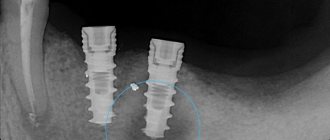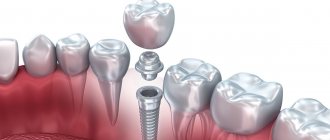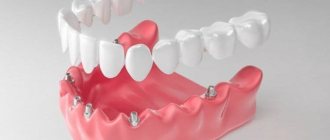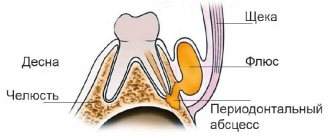With the development of implantation technology, more and more patients prefer this method of restoring lost teeth, as the most reliable, aesthetic and convenient. Set it and forget it! This is exactly what happens in most cases, unless the plans of the doctor and his patient are disrupted by the most formidable complication, due to which the implant can be lost - peri-implantitis. This is what visitors to numerous dental forums scare each other with, so much so that some give up the idea of installing an implant altogether. In this article, let's figure out what peri-implantitis is, how to avoid it, and, if necessary, treat it.
What is peri-implantitis?
Peri-implantitis is an inflammation of the tissues and bone surrounding the implant, which ultimately, without timely intensive treatment, leads to bone loss and loss of the implant.
Peri-implantitis is much easier to prevent than to stop a process that has already begun. The main cause of the disease is a bacterial infection, which can occur either at the moment of implantation, and then the symptoms of the disease appear a few days after the operation, or after some time - from several months to several years.
Pathogenesis of peri-implantitis
Typical factors in the pathogenesis of peri-implantitis are the formation and suppuration of a hematoma in the gum tissue, as a result of which the implanted rod becomes excessively mobile. The mobility of the implant, in turn, leads to constant injury and destruction of bone tissue.
The disease goes through four stages of development. At the first stage, an inflammatory process and a slight decrease in bone tissue are observed. As the pathology develops, the height of the bone decreases even more. At stage II, vertical bone defects just begin to appear; at stage III, they spread along the entire implant. At the last IV stage, bone tissue resorption occurs.
Why does peri-implantitis occur?
According to statistics, during implantation, more than 95% of implants are successfully installed and take root. 5% of failures are associated with various reasons, but in approximately 1% of cases, peri-implantitis is “to blame” for the loss of the implant, i.e. inflammation affects approximately 1 artificial tooth root out of 100. You need to understand that complications are possible with any surgical intervention. It depends on the patient's health and immune system. If the patient has disorders or may have a decrease in immunity under the influence of unfavorable external factors, this must be taken into account. That is why implantation requires preliminary thorough diagnosis by the surgeon.
Other causes of implant infection and the development of peri-implantitis can be:
- Incorrect behavior of the patient himself after implantation:
- poor hygiene,
- violation of the treating dentist’s recommendations for the care of implants,
- increased chewing load, careless attitude towards your artificial teeth, gum injuries near the implant,
- smoking,
- ignoring routine examinations to monitor the condition of the implant roots.
- Mistakes made by specialists during implantation:
- an inappropriate prosthetic technique was chosen,
- the implant is placed in the wrong place,
- the implant is installed in a hole with a larger diameter than required,
- the load on the implant was incorrectly calculated,
- a complete diagnosis was not carried out and/or the patient’s health status was incorrectly assessed before implantation,
- During the operation, asepsis was violated.
- A low-quality implant was installed. This can happen due to the fault of the dentist or at the insistence of the patient himself.
- There was a source of infection in the patient's mouth - caries, periodontal disease, dental plaque and calculus. In order for implantation to proceed without complications, all sources of possible infection in the oral cavity must be eliminated at the preparation stage.
Complications after dental implantation in the lower jaw?
Complications after implantation of lower teeth are less common, since the procedure itself, according to doctors, is much simpler. However, there are some nuances here too. For example, if the walls of the mandibular canal are damaged, the lower lip and part of the chin can be deprived of sensitivity. Also, severe numbness of the oral cavity for 2 weeks or more (up to 6 months) can occur if the trigeminal nerve of the mandibular branch has been affected.
The appearance of severe bleeding indicates that the facial artery has been damaged.
EXPERT OPINION!
Most complications can be avoided at the preoperative stage. That is why the “Dr. Fedorov Implantation Center” pays due attention to it. We allocate enough time for examination, CT scan (on one of the most powerful and safest machines in the world), collection of tests, sanitation of the oral cavity and other procedures.
Thanks to this, our patients receive a carefully thought-out treatment plan, and subsequently new teeth that will serve them for decades.
Kozadaev Sergey Igorevich
Dentist, surgeon, implantologist.
Clinical experience 10 years.
Symptoms of peri-implantitis:
- The disease begins with redness, discomfort and swelling of the gums in the area of the installed implant.
- There is bleeding of the gums in the problem area.
- At the site of inflammation, connective tissue begins to grow.
- The gum moves away from the implant, as in periodontal diseases, and a periodontal pocket forms around the titanium rod.
- Serous fluid and pus may be released from the pocket, and a fistula may form.
- The X-ray image reveals a noticeable loss of bone tissue around the implant.
- The implant becomes loose, the patient feels its mobility, this provokes further destruction of the bone around the titanium rod.
- Ultimately, if the inflammatory process is not stopped, implant rejection occurs.
For what reasons can a fistula occur in the implant area?
The appearance of a fistula on the gum after the installation of a dental implant (both immediately and at any time after) indicates the occurrence of a complication after surgery or the development of inflammation against the background of existing periodontal diseases. This is a dangerous condition that requires immediate attention to the dentist. In a good way, the patient should be alert even before the fistulous tract appears, when pain, swelling and redness on the gums begin to bother him, and not take it to the extreme.
The causative agents of the pathological process are streptococci, gonococci, Staphylococcus aureus. It may take a week from the formation of an abscess to the appearance of a fistula tract.
The appearance of a fistula after implantation is rare. In the photo you can see what it looks like. The causes of this condition are divided into two large groups – those caused by the implantologist’s mistakes, and those caused by the patient’s own actions.
Reasons due to the fault of the implantologist:
- choosing a low-quality implant,
- incorrectly selected design that does not correspond to the size and shape of the bone bed,
- installation errors,
- violation of aseptic and antiseptic rules during surgical procedures: infection on the implant, infection of the socket,
- ignoring or untimely detection of inflammatory processes in the gums and adjacent teeth, insufficient, poor-quality preparation for implantation and sanitation of the oral cavity,
- incomplete medical history, failure to take into account concomitant diseases and conditions affecting the osseointegration of the implant.
The second group of reasons (from the patient’s side) are:
- excess load on the implant and tissue injury during the rehabilitation period and in the future,
- non-compliance with doctor’s recommendations for taking medications and treating the oral cavity (especially against the background of periodontitis),
- insufficient hygiene after implantation, irregular preventive visits to the dentist.
To learn about what you need to consider when planning to install implants, read the material “How to prepare well for dental implantation: necessary examinations, tests and treatment.”
How is peri-implantitis treated?
The success of treatment for peri-implantitis depends on what stage of the disease it is started at: the earlier, the better the prognosis.
Treatment is aimed primarily at relieving inflammation in the area and restoring bone volume once it has begun to be lost. Therefore, there are 2 main stages in treatment - sanitation of the inflamed area and surgical bone augmentation.
- Before starting treatment, the doctor conducts a diagnosis. The main stage of such a diagnosis will be a 3D CT scan to accurately determine the affected area and the condition of the bone tissue.
- Then professional hygiene of the implant and adjacent areas is carried out - removal of soft dental deposits and tartar from the dental crown and from the subgingival space using ultrasound.
- Next, surgical sanitation of the area of inflammation is carried out - the abscesses are opened. Cleaning of periodontal pockets is carried out in the same way as for periodontal diseases - using special curettes or the Vector device. It is advisable that the problematic implant is not loaded.
- At the same time, bone grafting can be performed using the method of directed bone regeneration using bone chips and regenerating membranes.
- In parallel, the patient is given local and general antibacterial therapy and antibiotics are prescribed.
- When treating peri-implantitis, it is very important to maintain daily hygiene using antiseptic drugs.
The result of treatment is necessarily monitored by repeated x-ray diagnostics.
It must be remembered that peri-implantitis is prone to frequent relapses, therefore, after treatment, monitoring the condition of the implants and increased attention to proper hygiene are MANDATORY.
What to do to prevent complications after implantation
To begin with, you should carefully choose the clinic where the implantation will be performed. Dentistry must have modern equipment and work with high-quality, proven dental systems, the manufacturers of which do not raise the slightest doubt. Doctors in the clinic must have the necessary skills, knowledge and experience. When choosing a dentist and implantologist, you should carefully study the reviews of real patients of the clinic.
For preventive purposes, you must visit the dentist at least every six months. If any discomfort or symptoms of the development of pathological processes occur, a visit to the dentist should be immediate.
After implantation, you should stop drinking alcohol, smoking, and avoid any mechanical damage to the gums, cheeks and jawbone. After implantation and a year after the operation, an x-ray should be taken, this will allow timely detection of jaw atrophy.
You need to brush your teeth twice a day, and you shouldn’t limit yourself to a regular toothbrush. To clean the oral cavity, dentists recommend using an irrigator, whose operating principle is to remove food debris and bacteria from the interdental spaces and periodontal folds using strong water pressure. Electric, ultrasonic and ionic toothbrushes will help to effectively clean the oral cavity.
Compliance with these recommendations minimizes the risk of complications after implantation surgery.
Prevention of peri-implantitis
From all of the above, it follows that peri-implantitis is much easier to prevent than to treat later. In order to protect yourself as much as possible from such a complication, both immediately after implantation and during subsequent life with an implant, you must:
- Carefully monitor oral hygiene, use not only a toothbrush and toothpaste to care for teeth and implants, but also special products - a monotuft brush, a dental brush, special dental floss and an irrigator. Visit a hygienist regularly for professional oral hygiene.
- Do not violate the recommendations of your doctor immediately after the implantation procedure.
- Pay attention to your health, strengthen your immune system, and don’t smoke.
- Regularly undergo scheduled examinations with your attending physician with RG diagnostics at least once a year to monitor whether there is bone atrophy.
- Carefully choose the clinic and doctor where you get implants.
- Place implants of brands that have already proven themselves among doctors and patients - in this case, the savings turn against the patient, because If the implant fails, you will have to undergo quite expensive treatment and pay for the implantation again.
Symptoms and diagnosis of mucositis
Inflammation of the soft tissues surrounding the dental implant is reversible and is not accompanied by bone loss. This is the initial stage of pin rejection. Symptoms characteristic of this period are:
- Swelling and redness of the affected area. The appearance of white spots.
- Thinning of soft tissues. Bleeding when pressed.
- Formation of ulcers on the gums, palate, and less often on the inside of the cheeks.
- Pain, itching, discomfort while eating or talking.
Dental problems are often accompanied by somatic manifestations
:
- Fever, general malaise.
- Inflammation of the submandibular lymph nodes.
- Increased fatigue.
- Dry mouth.
Doctors note the presence of fluid inside the grooves of the implant. Suppuration is not typical for the disease. Modern studies indicate that implant mucositis occurs more often when installing pins with microthreads, grooves, and a rough surface.
If hard tissues become inflamed, then we are talking about peri-implantitis - its course is more severe, the area of inflammation is in close contact with the bone. With periodontitis, the gum pocket is separated from the bone by an insulating layer, but in this case, the hard tissue around the prosthesis is not protected from pathogenic microflora. An accurate diagnosis and the degree of development of the disease can be established by comparing the X-ray taken after implantation and the current one when reporting complaints.
Diagnosis of mucositis is characterized by a special approach - it is necessary to exclude other ailments with similar manifestations.










